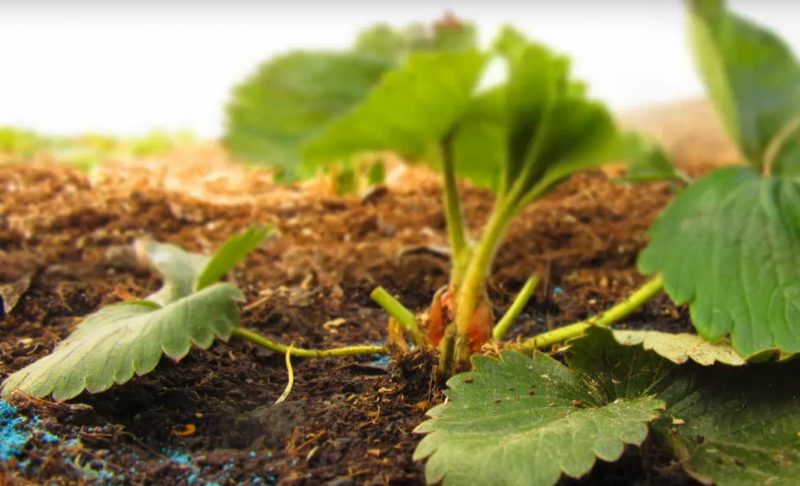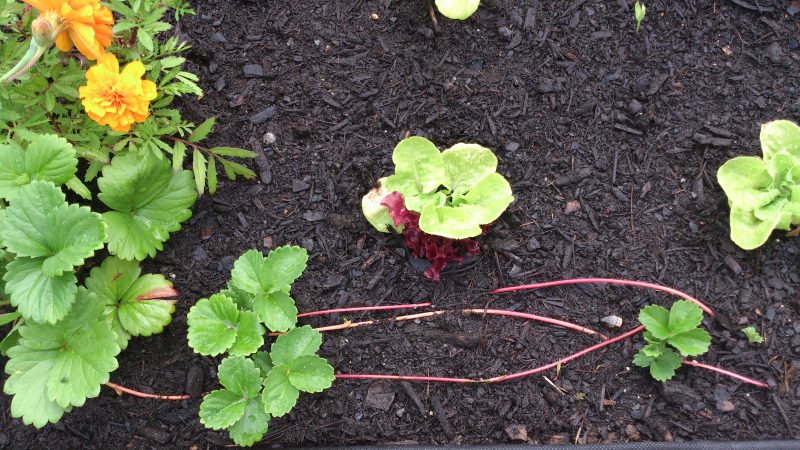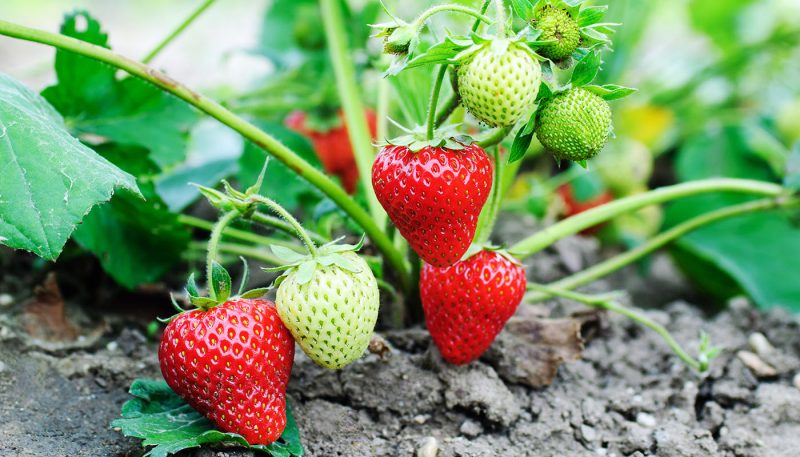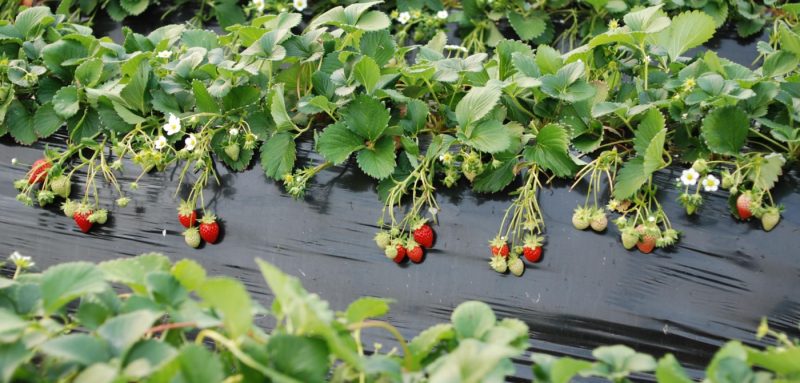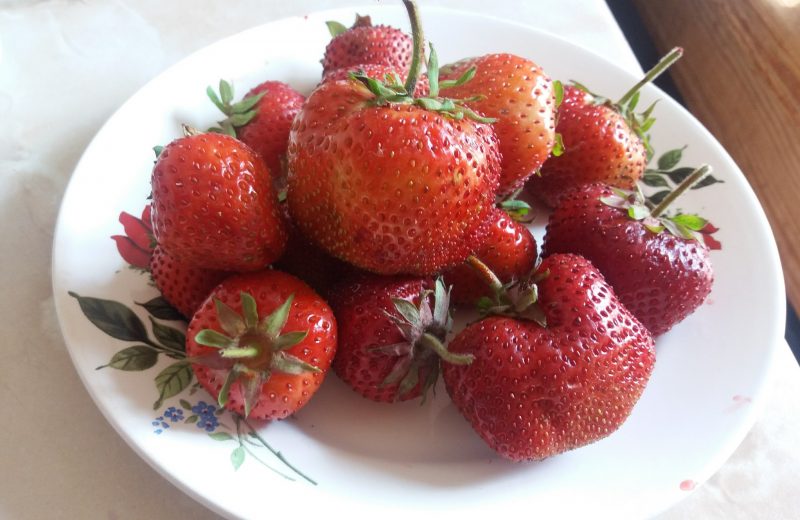Care for strawberries in the spring should be especially thorough, because the productivity of the berry directly depends on this. Read the rules for growing bushes with fragrant berries in detail in our article.
Material Content:
Features of spring strawberry care
In spring, all berry crops require increased attention. Care at the beginning of the growing season is especially important.
How to take cover after winter
Few gardeners make full-fledged shelter for strawberries for the winter. Usually, only a layer of mulch is poured on the beds to cover the roots of the bushes. You can use fallen needles or leaves as a covering material. But in no case should these materials be left in the garden in the spring, hoping that they will naturally decompose.
In the middle lane, shelter from strawberries is removed in the first decade of April. During this period, leaves begin to grow on rosettes. Mulch can be removed with a rake, and the ground under the bushes can be cleaned manually. All dried and frozen shoots are removed during plantation cleansing.
Soil cultivation and mulching
Be sure to remove soil and mulch the bushes after removing the shelter in early spring. Loosen the earth around the outlets very carefully so as not to damage the roots. It’s enough to deepen the hat by 3-4 cm.
Mulch around the bushes performs several tasks simultaneously. Firstly, a layer of protective material protects the root system from drying out, as it reduces the evaporation of water. Secondly, it does not allow weed to grow on the bed, which greatly facilitates the care of plantings.
Strawberries are also called “straw” berries, as they are often mulched with straw. The lined grass protects the ripening berries from contact with the ground, and even after watering the crop will still remain clean.
Lay out mulch on strawberries around the beginning of May. As a protective material, you can use grass, sawdust, compost or needles. Of inorganic materials, gardeners use agrofiber and black film.
Spring Watering Rules
It is not difficult to determine the dates when it is necessary to start strawberry irrigation. Usually in cold regions, the beginning of these events coincides with the first decade of May. In warm places, watering the berry begins in mid-April. Therefore, many gardeners begin to water when the land is dry on the beds.
Before the very first time, you should clean the beds from the old mulch. It is worth considering that strawberries can not tolerate cold water, so for spring irrigation water will have to be slightly warmed up. About 500 ml of water for one irrigation is enough for young bushes, while for adult plants they spend 10 liters of water per square meter of land.
When the bushes begin to grow actively in the spring, it is advisable to sprinkle. But when flowers appear, watering the berry begins only at the root.
The gardener should take into account that excess moisture leads to the growth of succulent leaves and peduncles, but such effeminate plants easily die due to May frosts. In addition, overflows create a beneficial environment in the beds for the development of various rot and other diseases.
Top dressing after winter, before flowering and during
Strawberry dressing is a very important event that must be carried out in the spring. Properly applied fertilizers will help not only to collect a rich harvest, but also serve as an excellent preventive measure against pests and diseases. But it is important not to overdo it with the introduction of nutritional compounds, since strawberries can begin to “fatten” - to build up green mass to the detriment of berries.
Immediately after winter, as soon as the weather is warm, it is useful to add chicken droppings or cow dung under strawberries. To prepare a nutrient solution in 10 l of water, dissolve 300 g of litter or manure and add 1 tbsp. l sodium sulfate. It is enough to pour 500 ml of fertilizer under each plant.
Young bushes in the first year after planting can not be fertilized at all. Adult plants need regular top dressing.
Strawberries are fed three times during the summer season:
- immediately after winter;
- before flowering or during;
- during the ripening of berries.
The first time fertilizers are applied at the end of April. If there is no organic matter, then as the first top dressing, you can use ready-made mineral mixtures for berry plants. The composition of such preparations includes amino acids and minerals, which have a beneficial effect on the development of bushes.
Mineral mixtures are poured under the bushes in the form of a solution or sprinkled dry. A great fertilizer for strawberries is yeast, which is also applied immediately after winter.
The second top dressing of the berry is carried out just before flowering. Mineral mixtures are used as fertilizers, which are guaranteed to increase the quality and volume of the crop. You can buy fertilizers for strawberries in a gardening shop. Use such drugs only strictly following the instructions.
Read also:urea fertilizer - application in the garden
- The drug "Chorus" has proven itself perfectly. It is enough to dilute 12 g of the composition in a bucket of water and pour the bushes.
- Good results, as many gardeners have noticed, give strawberry fertilizers with Topaz. To prepare a nutrient solution, it is enough to dilute 6 g of the drug in a bucket of water. After two weeks, the treatment with mineral fertilizers is repeated.
- Useful for strawberries before flowering and foliar top dressing. Foliar fertilizers can be highly mobile and low mobile. The former include magnesium, potassium, nitrogen and phosphorus. These nutrients instantly penetrate the roots.Low mobility fertilizers contain iron, boron, manganese and copper. Such compositions act somewhat more slowly. Foliar fertilizers are sprayed very carefully, trying to ensure that drops of the solution fall into the ovaries.
Strawberry care during flowering is not only watering, but also the mandatory introduction of nutritional compounds. During flowering, it is useful to feed the berry with wood ash.
This requires 200 g of ash, pour 2 liters of boiling water and leave for 2 hours. Then, 3 g of manganese and the same amount of boric acid are added to the solution. Strawberries are very responsive to the introduction of iodine during flowering, and therefore 1 tbsp. Is added to the prepared nutrient solution at the end. l of this drug. The resulting mixture is added with pure water to a volume of 10 l. Fertilizer consumption rate of 200 ml per plant.
How to handle disease and pests
Open strawberries can be affected by various diseases. Also on this berry, especially if the strawberry is remontant, the stem nematode and the strawberry mite can attack.
- A mite is a very serious parasite, an attack of which can even lead to the death of a plantation. These little bugs hibernate under fallen leaves, and in the spring they begin to eat strawberries. Increased soil moisture can lead to the rapid spread of insects.
- Stem nematode is common in all regions of Russia. The insect can cause crop loss and threatens plants. The parasite propagates in the tissues of the strawberry bush. The parasite tolerates weather extremes and quickly leads to the death of plantings.
First of all, to prevent the attack of insect pests, you should remove all garbage from the beds in early spring. All plant debris, dried leaves, frozen parts of plants should be removed.
Experienced gardeners know that strawberries should be treated from pests in the fall. But if at the end of the season these procedures were not carried out, then you can spray the bushes before flowering "Karbofos" or a preparation of colloidal sulfur.
- The most common disease of garden strawberries is white spotting. The main symptoms are the appearance of spots on which holes form over time. This is a fungus that hibernates in fallen foliage. To prevent the disease, strawberries after flowering (after about 10 days) and after picking berries are treated with a solution of Bordeaux liquid. If the disease has developed very strongly, you will have to treat the bushes with Horus, diluting 7 g of the drug in a bucket of water.
- Still garden strawberries can get brown spotting. Due to this disease, the leaves dry out and the berries do not set. The reason for the development is too thickened landing. The disease can also be carried by the wind. The fungus hibernates on the leaves, so spring should be cleaned up in the beds. Control measures - the application of fertilizers, for example, superphosphate or ammonium nitrate.
Transplant Nuances
Through spring transplantation, many gardeners rejuvenate their strawberry plantations. But the sockets should be planted correctly, otherwise you can lose the crop. When choosing a transplant time, you should first focus on the temperature of the soil. In climatic conditions of the middle zone, usually this moment falls at the end of April or at the beginning of May.
The indisputable advantage of spring transplantation is a guarantee that the sockets will have time to root well and get stronger before frost.
For transplanting, it is best to take bushes up to two years old. Outlets of the first year are suitable, which mustaches give a lot for last season. Young outlets should be separated from the adult mother bush and planted in a new place.
The landing technology is as follows:
- First, the selected area is dug up on a bayonet.
- The earth is leveled with a rake and landing holes are made according to the size of the roots.
- The seedling is lowered into the hole so that the heart remains at the level of the soil, and sprinkled with earth.
- Strawberries are watered and mulched.
It is widely believed that only the first rosettes on the mustache are suitable for landing.In fact, sockets of the second and third orders are also suitable for reproduction, but they will yield a little later.
What is the difference between care in different regions of Russia
In different climatic zones of Russia, strawberry care in the open field is somewhat different. For example, in the northern regions, it is not worth planting strawberries in the fall, since in the north it is short and cold, and planting material simply dies.
- In the north, it is better to plant strawberries in the spring or at the end of summer so that the plants have time to take root and prepare for the cold.
- In the south, on the contrary, spring is too short and hot, and therefore, when planting, plants die due to lack of moisture and plenty of sun. In the southern regions, landing in the fall is justified.
When growing this berry in the north, there is no urgent need to monitor soil moisture, since it often rains in summer. In the south, you have to constantly monitor the soil moisture and water strawberries very often, avoiding drying out of the roots.
Tips and advice from experienced gardeners
To care for strawberries in the spring you need to be very careful to get a high harvest. What are the tips of experienced gardeners and tricks to help grow a lot of fragrant and large berries?
- Many experienced gardeners advise in the spring to cover strawberries with agrofibre. Spandex 90% darkens the soil and prevents weeds from breaking through. But at the same time, this material passes air and moisture to the roots. So many gardeners save energy on care and get a completely pure berry.
- Some advise mulching strawberries only with sawdust. The whole bed is completely covered with sawdust with a layer of up to 8 cm. So moisture does not evaporate from the soil, and the mulch lies up to 3 months.
- As for plant transplants in the spring, gardeners recommend never removing the soil from the roots of seedlings, since the root system can quickly become dead due to contact with air.
Growing strawberries is a rather painstaking work, but very grateful. For attention, care and time spent, the gardener will receive a generous harvest of sweet berries!



